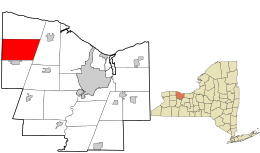Clarkson, New York
| Clarkson | |
| Town | |
| Country | United States |
|---|---|
| State | New York |
| County | Monroe |
| Elevation | 368 ft (112.2 m) |
| Coordinates | 43°15′07″N 77°55′19″W / 43.25194°N 77.92194°WCoordinates: 43°15′07″N 77°55′19″W / 43.25194°N 77.92194°W |
| Area | 33.2 sq mi (86.0 km2) |
| - land | 33.2 sq mi (86 km2) |
| - water | 0.1 sq mi (0 km2), 0.3% |
| Population | 6,736 (2010) |
| Density | 203/sq mi (78/km2) |
| Established | 1819 |
| Town Supervisor | Paul M. Kimball (R) First election 1983
|
| Timezone | EST (UTC-5) |
| - summer (DST) | EDT (UTC-4) |
| ZIP code | 14430 |
| Area code | 585 |
|
Location in Monroe County and the state of New York.
|
|
|
Location of New York in the United States
|
|
| Website: http://www.clarksonny.org/ | |
Clarkson is a town in Monroe County, New York, USA. The population was 6,736 at the 2010 census. The town is named after General Matthew Clarkson.
The Town of Clarkson is on the west border of the county and is west of the City of Rochester.
General Matthew Clarkson was an extensive landowner in this locality, who gave 100 acres (405,000 m²) to the town. Clarkson was formed from the Town of Murray, on 2 April 1819. Clarkson was reduced to form the Towns of Union (the present town of Hamlin) in 1852.
It has been claimed that Moddy Freeman was the first settler in Clarkson. James Sayres purchased at Clarkson Corners in 1804 and was the first settler on the Ridge Road. Eli Blodgett also settled here in 1804, and there were many others prior to 1809. In 1819 and a year or two thereafter, settlement and development progressed rapidly. It was the home of Henry R. Seldon, judge of the Court of Appeals, and later lieutenant governor of the State of New York. The first male child born was a son to Mrs. Clarkson; the first female birth was that of Betsey Palmer, in 1812. Charlotte Cummings taught the first school, in 1812. Henry McCall kept the first store, about 1810. Isaac Williams built the first frame house, and was the first blacksmith. Dr. Noah Owen was the physician and Dr. Rowe the second. John Bowman was the first lawyer. The first and about the only newspaper published in Clarkson was the Jeffersonian, in 1835, which continued for only a year. The first sawmill was erected previous to 1811, by James Sayres, and stood a half-mile east of the corners. Several distilleries were among the early industries along the Ridge Road. A post-office was established in 1816, Dr. Baldwin being the first postmaster..
The Ridge Road was an important thoroughfare during the war times of 1812-15, and Clarkson was the general rendezvous for troops and the temporary depository for supplies and munitions of war. Clarkson village, then known as "Murray Corners," was a hamlet of considerable note, the Ridge Road being the main route between Canandaigua and Lewiston. The Corners was a stopping-place where horses were changed and travelers allowed a brief respite, but since the completion of the Erie Canal, and the still later construction of the New York Central railroad, the town of Sweden; has gained an ascendency and profited, while Clarkson; has correspondingly lost in commercial importance.
...
Wikipedia


